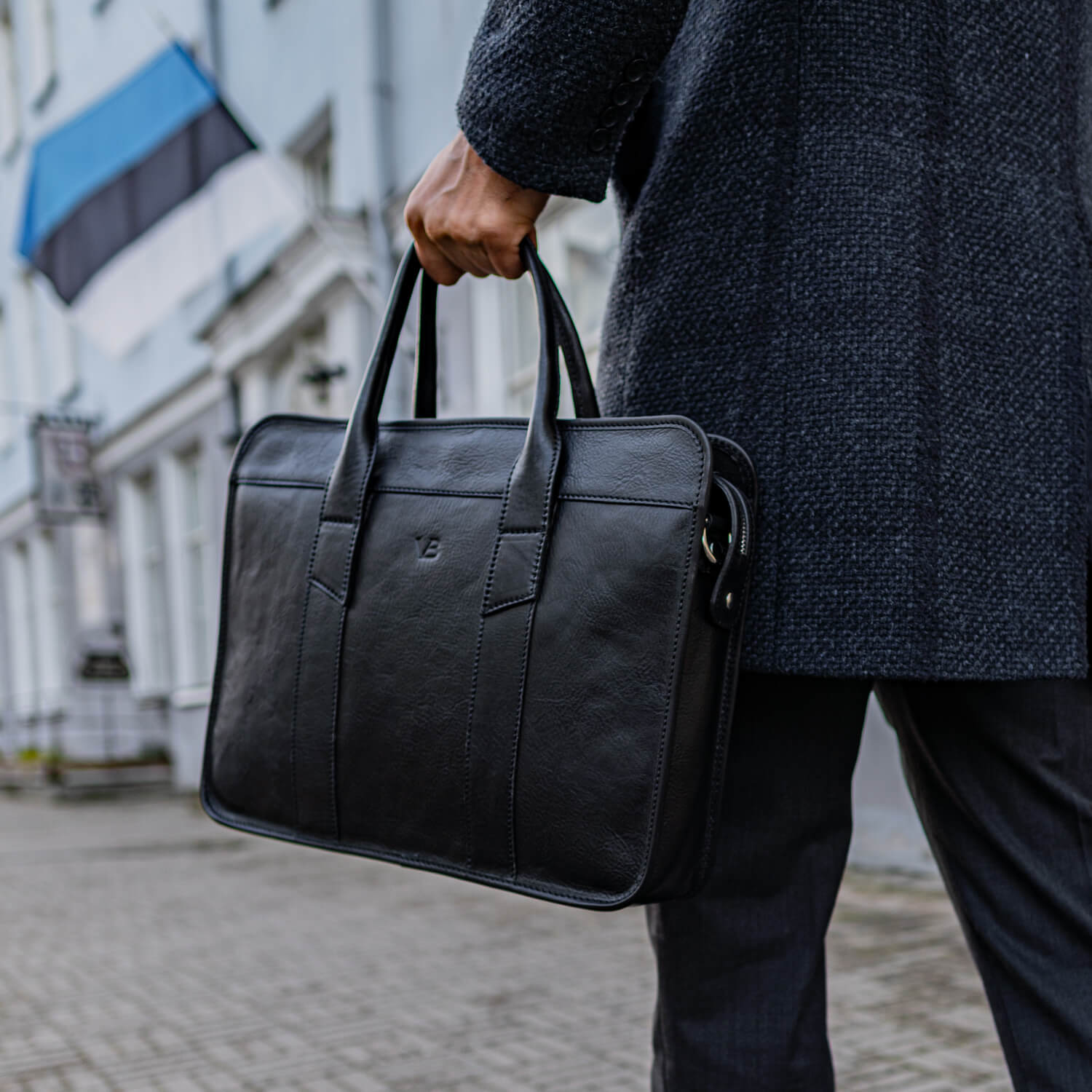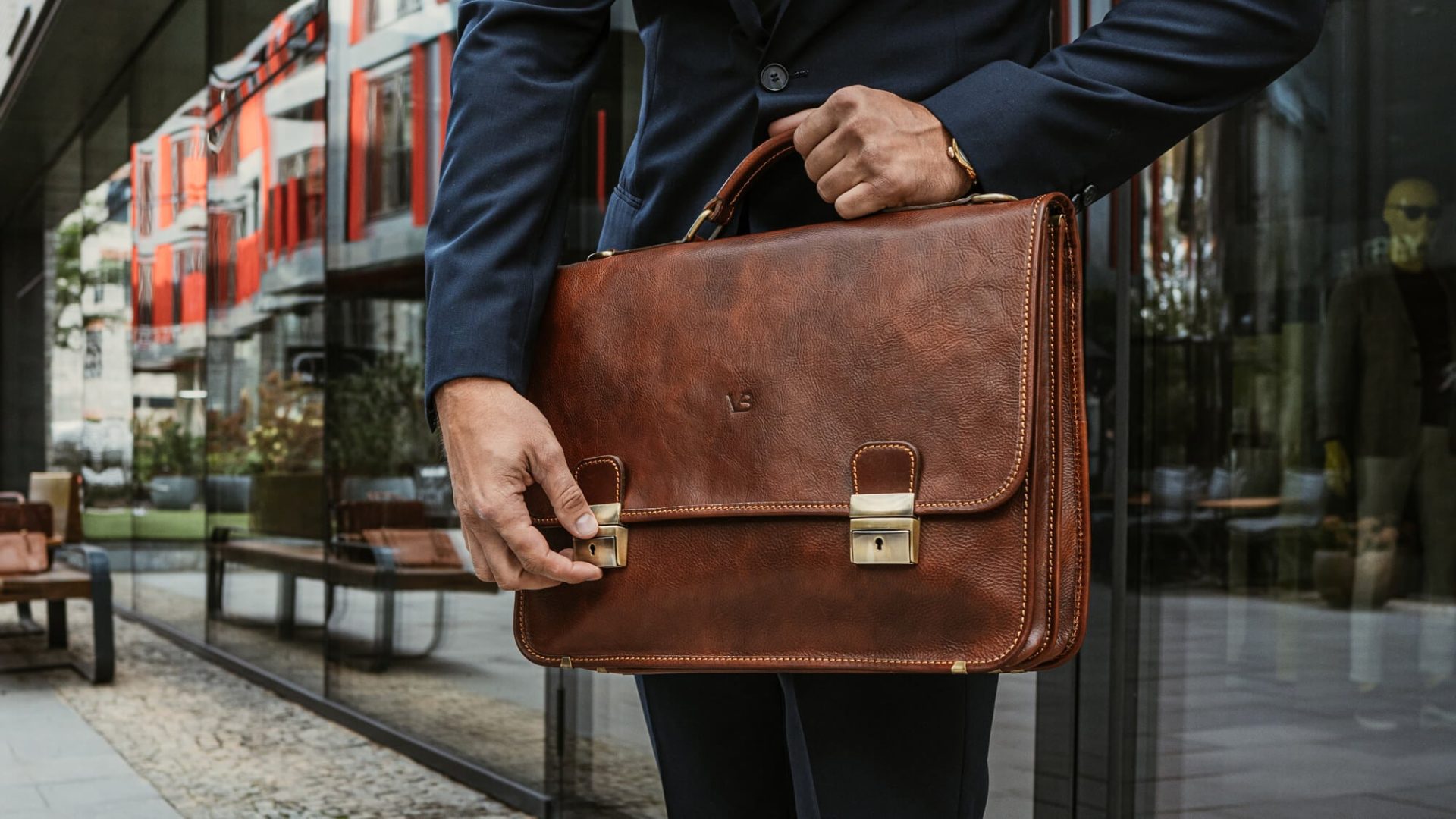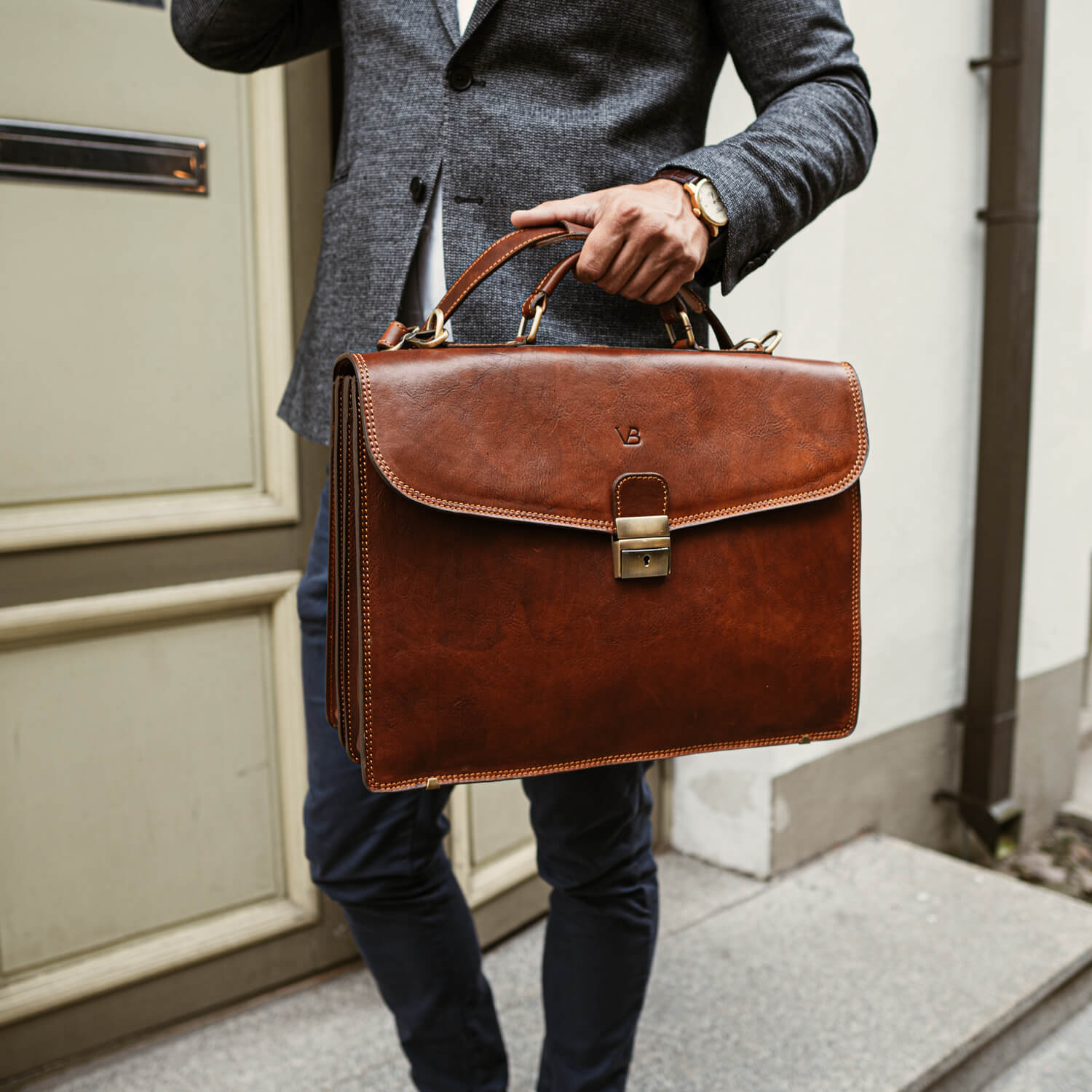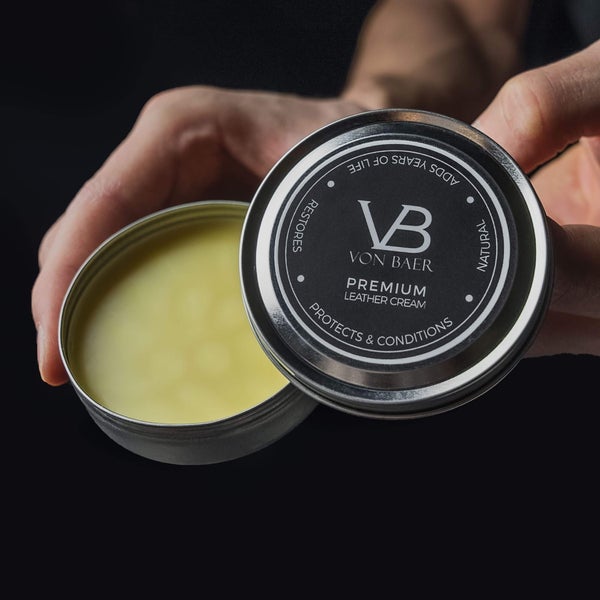
We’ve all been there, staring down at our prized leather item and thinking it’s all over but the crying – but with a quick reaction, a little patience, and a little effort, you can restore your favorite bag, jacket or satchel to its former glory.
It doesn’t matter if you got caught in an unexpected rainstorm, were splashed by a passing car, or accidentally set your item down on a wet surface, with the right advice you can escape disaster and set things right.
How does water affect leather?
Leather can get wet, and depending on the finish and treatment, you might even get away with it without having to do anything in response to it. When leather gets wet, the water molecules bond to the oils in it and draw them out as the water evaporates. It also moves the dyes around, destroying a smooth, even color and creating spots and streaks. The result can be a spotty, stained appearance and a loss of the suppleness of the leather, leaving it brittle… even cracked. If the water takes a long time to evaporate, the leather can even begin to rot.
What to do if your leather bag gets wet:
So, if you find yourself coming out of the other end of a rain shower, or standing in a dripping mess watching taillights disappear into the distance, or picking up your favorite bag from the chair beside you and only then noticing the pool of water on the seat, fear not! A few simple items and some quick, determined action can save the day – and your favorite leather item.
First, get your hands on:
- a dry cloth
- a sponge (or microfiber paper towel works)
- a soft-bristle brush (a toothbrush can work)
- some leather conditioner
- some padded hangers
- some newspapers or similar absorbent materials.
Do this quickly; the faster you get started, the better the result will be. If the water has time to set, there might be some irreversible damage. Even if you don’t quite make it in time, you can still minimize the damage by acting as quickly as possible… and we have a few ideas (see below) for those leather items that are already stained.
Smooth vegetable-tanned leather is more susceptible
Most smooth leather is made from the strongest part of the animal hide, is full-grained, and vegetable-tanned. This preserves the outermost layer of the animal skin and means that it is often left with its natural finish. This looks great, but it means that it is more susceptible to damage, as it absorbs water more readily.
For this kind of item, a little protection before the spill is a great idea. When an accident does occur, however, drying the item – using the right technique! – is important.

How to dry wet leather
The first thing to do is clean your hands with soap and water. Human hands have natural oils on them, and those oils are easily soaked up by leather, which can cause more staining when the leather is wet.
Then gently dab off the excess water drops from the leather, both inside and outside, being careful not to rub or scrape the surface of the leather.
The next step is a tough one: after dabbing away the obvious water drops, set the item is an airy, clean place and… wait. Let the water evaporate on its own, shifting from wet, to damp. Don’t wipe it. Don’t blow dry it or try to rush this part, or shrinking and deformity may occur. Patience is key.
Some items also have specific positions that best suit the drying process:
- A Wallet – dry in the closed position, so any hardening will mean that it sits naturally in the closed position, rather than straining to flatten out and be open. Opening a stiff wallet is easy enough, and the leather should soften up a bit with time and use.
- A Bag or Purse – stuff it with newspaper or another absorbent material until it is its usual shape, then let it dry lying more or less flat, depending on the shape of the bag. Wider, chunkier bags with some architectural stiffness may dry better sitting up.
If the bottom of the item is wet, placing it on a VERY clean drying rack (for baked goods) might help with airflow below it. Do this only if you don’t mind some crisscross patterns potentially occurring on the surface touching the drying rack.
Once the leather is no longer wet, but still damp, apply a leather conditioner to it. Higher quality is always better in this case, and something like Carl Friedrik’s Leather Cream is a great choice for natural or vegetable-tanned leather items like Vachetta. These conditioners contain oils that the leather will absorb deeply, replacing oils lost to the water as it evaporated. Work the oil thoroughly into the leather. Leave it to dry for 8-10 hours.
After your patient vigil (or a good’s night’s sleep), buff the now-dry surface of the item, being careful not to miss any of it. With some luck, the item should look as good as ever… sometimes even better!
Since you have it out, and you’re doing some work on it anyway, this is a great time to apply some stain repellant or waterproofing to protect it against that next mishap.
Treating Dry Water Stains on Tanned Leather

As we promised above, we will not leave you hopeless if you didn’t catch that water stain in time, or if you own an item with water stains long-since set and settles. There are still steps you can take to improve the condition of your prized item.
Start with a high-quality leather cleaner.
It should be fine, but to make sure, test it somewhere on the item where a stain won’t show (or won’t matter) – perhaps inside the sleeve of a jacket, inside a purse, or on the base of a large bag. If treating furniture, tip the item up and test on the underside, where the trim is folded under.
Once your test has dried and you’re happy that there is no unexpected reaction, put some of the cleaner on a clean cloth and gently rub it over the entire leather surface, paying special attention to the stained areas. Some leather cleaners come with cloths specifically designed for this. Wipe off any excess that is not absorbed by the leather. Now let the whole thing dry in a cool place, indoors, away from any heat sources, and out of direct sunlight.
When dry, apply conditioner to the item. It is best to do the whole item, not just the stained spots, as any subtle changes in the coloration of the leather will be more uniform. Buff away any residue and return it to dry in the same kind of protected space as you did after the cleaner.
Treating Water Stains on Grained/Patterned Leathers
Grained or patterned leathers are usually not vegetable-tanned leathers. They are usually chrome-tanned and finished, then covered in a layer of paint, then finished off with a protective layer. The good part about all of these layers it that they give better protection against water absorption, and are less likely to get stained even if some water does get in.
If you’re not sure if your item is of the vegetable-tanned variety, or the grained/chrome-tanned variety, check the label for terms like “pebble-grain” or “Saffiano Leather” – these are typically grained leathers.
If the leather’s still wet
If your grained of chrome-tanned leather is still wet, it requires some quick action on your part. First, wash your hands with soap and water to remove dirt and any of your natural oils from the surface of your skin, then dry your hands.
With a cloth r colorfast sponge, gently dab or blot the excess water from the surface of the item – do NOT rub, wipe or scrape at this point or you are likely to cause more damage. Let the leather dry in a well-ventilated area, away from direct sunlight, until it is no longer wet, only damp.
Some items also have specific positions that best suit the drying process:
- A Wallet – dry in the closed position. That way, if there is any hardening it will still sit naturally in the closed position, rather than straining to flatten out and be open. The leather should soften up a bit with time and use, making it open more or less as normal.
- A Bag or Purse – stuff the item (gently) with newspaper or other colorfast absorbent material until it is its usual shape, then let it dry lying flat, depending on the shape of the bag. Wider, chunkier bags with some architectural stiffness may dry better sitting up.
Never use a hair dryer or heat rack to dry a leather item, as the heat could cause uneven shrinkage, resulting in deformation of the item.
Once the item is better described as “damp” than “wet,” apply it all over with a leather conditioner to restore lost oils and retain the suppleness of the item. Massage the conditioner in, wipe off any excess that won’t absorb, then leave it for 8-10 hours to dry.
Once it is dry, buff the whole surface and then protect your work with a spray that will repel water and stains in the future.
If there are existing stains on your grained or patterned leather, follow the same steps as you would for vegetable-tanned leather (included above).
Treating Water Stains on Suede
Suede is a great-looking leather finish, but it is also one of the most easily ruined. The finish is also difficult to waterproof. It cannot be sealed up or waxed by hand, so the only real option is a spray.
When the water hasn’t dried:
First, you must act quickly. Take a dry cloth or microfiber paper towel and dab away the water. Be sure not to rub or scrape at the leather. Once this is done, take a medium-bristle toothbrush and gently wipe the suede back and forth. A couple of minutes should do the trick, but it’s best to keep an eye on it and judge for yourself when the surface is getting back to a normal appearance.
Next, you’ll do something that you wouldn’t do for other types of leather finish. Take a hair dryer and blow air over the surface of the sued, brushing while you do so. Set the heat level to cool or low and be careful not to heat up the leather. The key is the airflow, and the brushing, so the nap of the suede is able to fluff up to its normal texture before hardening. Once it hardens, it cannot be revived to its normal look.
Once the suede is back to its normal look, spray it with an appropriate water and stain repellent.
If it has dried:
If your wet suede item is allowed to dry without any kind of treatment, returning it to its usual look is nearly impossible. You can, however, improve the look of already-dried water stains on a suede item with a few easy steps.
Dampen a lint-free cloth and use it to dampen the surface of the sueded. Avoid getting the suede really wet though. Apply it from seam to seam, not just on the stained area, as this will help to attain an even result when finished. Gently brush the surface with a medium toothbrush for a few minutes and then let the suede slowly dry out. The difference between the stain and the rest of the suede should – hopefully – be much less.

Nubuck leather
Nubuck leather is created by buffing down full-grain leather until it is very fine, hard-wearing suede. This treatment makes the leather more water resistant, but still does require waterproofing to protect it from more than little, incidental drops. If it is hit with substantial water, it will still need to be treated.
When the water hasn’t dried:
The first step is to dab away the excess water without rubbing or scraping the surface. Use a dry cloth or paper towel to do this and be sure to be gentle. Do not rub the liquid into the leather or you risk making the problem worse.
Once the excess is removed, use a soft brush to brush the suede back and forth, top to bottom and bottom to top, for a couple of minutes. Once this is done, place the leather in a dry, airy place out of direct sunshine and away from strong heat sources. Leave it there to dry. This can take several hours, so leaving it overnight is often a good idea.
Once it is dry, apply a high-quality leather conditioner. This can be repeated once or twice a month to keep the leather supply and looking great.
If it’s dried:
If your nubuck leather item already has stains in it, follow the same steps we gave for regular suede and you will be able to minimize, and in some cases remove, the obvious signs of staining.
Water on Faux/Vegan Leather
If you’ve ever wondered if faux or vegan leather can safely get wet or been preoccupied with keeping it dry just in case, you can relax. Faux (and vegan) leather can take a lot more soaking than animal leather and still be absolutely fine. The reason for this is that it is made of a polyurethane plastic (or sometimes pineapple and apple) and has the strong water-resistant qualities of that material. In most cases, water won’t do it any harm at all.
If it does get dirty, however – maybe a spilt cocktail, a bit of oil, or some splatter of sauce – it should be easily cleaned with a mild detergent and/or a damp cloth.
The only downside of this is that it also repels conditioning products, so it has less protection from drying or cracking at it ages, especially if it spends a lot of time exposed to UV rays from the Sun.
Dry wet leather bags and briefcases
A few quickly performed steps, tempered with patience, will prevent much damage from your leather bag or briefcase. First, lay it on a table or similar surface to prevent the leather from wrinkling. Fill the inside of the bag with crushed newspaper to keep the shape while absorbing moisture. Let it dry slowly in ambient air – don’t rush it with a dryer, radiator, or sunshine.
Preventing leather from getting wet
The best way to keep your leather items looking great is to treat them before a problem or accident even occurs. Leather can never be 100% waterproofed, but some treatments (sprays or creams) can certainly help push it in that upward direction.
Non-suede and non-nubuck items should be treated with a leather conditioner at least every six months or so. Using a clean cloth, rub some on with a tight, circular motion, then wipe off the excess with a slightly damp cloth and let it dry.
We recommend the JUNYUAN Premium Leather Cream.

Beeswax cream is also a good choice, but doesn’t apply well to some leathers, so always test it in an inconspicuous spot before applying to the whole item. The item should be very clean before applying the beeswax. Apply a small amount of the wax to a dry cloth, then rub it onto the leather. A second application is often needed. Let it dry for about an hour, without rushing the drying process with heat sources or sunshine (rushing things can cause cracking). When dry, buff the surface with a clean, dry cloth to remove excess wax.
Don’t use beeswax on suede or nubuck leather, as it will ruin these finishes. Instead use a waterproofing spray.
For faux or vegan leathers, use a synthetic spray if desired.
Ten articles before and after
What is Vegetable Tanned Leather & How Is It Made? – JUNYUAN Bags | Professional Bag Manufacturer
Best Large Wallets for Lots of Cash or Cards – JUNYUAN Bags | Professional Bag Manufacturer
Leather Patina – The Complete Guide to Leather Patina – JUNYUAN Bags | Professional Bag Manufacturer
Waterproof Laptop Backpack craftsman tool bags




 Mobile/What's App/Wechat
Mobile/What's App/Wechat E-Mail
E-Mail ADD
ADD




